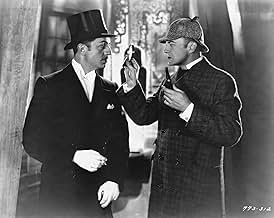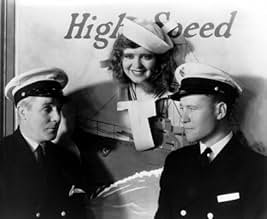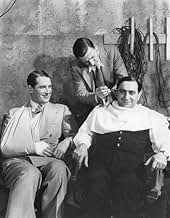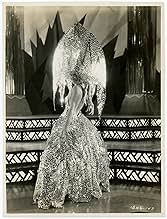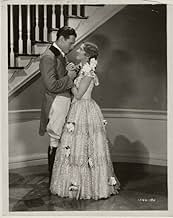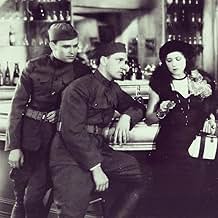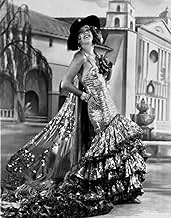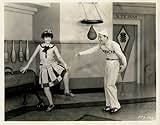AVALIAÇÃO DA IMDb
5,6/10
413
SUA AVALIAÇÃO
Adicionar um enredo no seu idiomaA musical revue that has Paramount stars and contract-players doing unrelated short sketches and elaborately staged song-and-dance numbers like a duet on a giant cuckoo clock and Clara Bow s... Ler tudoA musical revue that has Paramount stars and contract-players doing unrelated short sketches and elaborately staged song-and-dance numbers like a duet on a giant cuckoo clock and Clara Bow singing aboard a navy vessel.A musical revue that has Paramount stars and contract-players doing unrelated short sketches and elaborately staged song-and-dance numbers like a duet on a giant cuckoo clock and Clara Bow singing aboard a navy vessel.
- Prêmios
- 3 vitórias no total
Charles 'Buddy' Rogers
- Buddy Rogers - Episode 'Love Time'
- (as Buddy Rogers)
Avaliações em destaque
I've just watched the current restoration and can add some information to the 2002 review.
The footage of the opening "Showgirls on Parade" sequence is missing but the sound survives.
The sound disc for "Isadore the Toreador" has been located (only a few days ago) and will be put into the next restoration with the surviving Technicolor footage..
Nino Martini's number is now complete, and in Technicolor.
The "Dream Girl" Technicolor footage survives but the sound is missing.
The "Gallows Scene" is missing most of the sound except for Dennis King's song.
The footage of the opening "Showgirls on Parade" sequence is missing but the sound survives.
The sound disc for "Isadore the Toreador" has been located (only a few days ago) and will be put into the next restoration with the surviving Technicolor footage..
Nino Martini's number is now complete, and in Technicolor.
The "Dream Girl" Technicolor footage survives but the sound is missing.
The "Gallows Scene" is missing most of the sound except for Dennis King's song.
"Paramount On Parade" is both a musical revue and a collection of skits by Hollywood stars who can sing and some who cannot. The entertainment value is uneven as some of their stints in front of the camera range from pretty good to mediocre, from Maurice Chevalier to George Bancroft, whose forte was gangster roles. The movie was an excuse for Paramount to showcase as much of their stable of stars as they could assemble, and there were quite a lot of them. I understand that there were a spate of star revue-type pictures produced around the start of the sound era, and this was another one in that mold.
The main reason to see this picture in 2010, I found, was as a museum piece, watching old stars that I had only heard of. Hadn't seen much of Mitzi Green to speak of, ditto Skeets Gallagher, and had never seen Harry Green before. From that standpoint it was fascinating, but maybe not for moviegoers older than me. There was a good skit with four old-time movie sleuths, Warner Oland, William Powell, Clive Brook and Eugene Palette (who was more of a movie dim-witted cop).
On the IMDb site it is clocked at 77 minutes but at Capitolfest in Rome,N.Y. (8/10), a 102 minute 35mm print restored by the UCLA film department was shown which made it extra special.
The main reason to see this picture in 2010, I found, was as a museum piece, watching old stars that I had only heard of. Hadn't seen much of Mitzi Green to speak of, ditto Skeets Gallagher, and had never seen Harry Green before. From that standpoint it was fascinating, but maybe not for moviegoers older than me. There was a good skit with four old-time movie sleuths, Warner Oland, William Powell, Clive Brook and Eugene Palette (who was more of a movie dim-witted cop).
On the IMDb site it is clocked at 77 minutes but at Capitolfest in Rome,N.Y. (8/10), a 102 minute 35mm print restored by the UCLA film department was shown which made it extra special.
This was the type of variety show which most of the studios made which was popular in the early days of sound. In this case, the film consists of various short sketches, including musical numbers, comedy bits, and even a dramatic scene. The stars include Maurice Chevalier, Clara Bow, Ruth Chatterton, Fredric March, Gary Cooper, George Bancroft, Jack Oakie, Skeets Gallagher, Buddy Rogers, Kay Francis, Jean Arthur, Mary Brian, Fay Wray, Evelyn Brent, Leon Errol, William Powell, Warner Oland, Clive Brook, Eugene Pallette, Lillian Roth, Stu Erwin, Helen Kane, Nancy Carroll, and Mitzi Green.
Paramount also enlisted a posse of directors, including Edmund Goulding, Dorothy Arzner, Ernst Lubitsch, Rowland V. Lee, Victor Scherzinger, and more. Several of the film's segments, including a few in early Technicolor, were missing from the copy that I watched. In fact, the segment featuring Cooper, Brian, Arthur and Wray only consisted of the intro. My favorite segments include the very silly detective bit with Clive Brook as Sherlock Holmes, Powell as Philo Vance, and Oland as Fu Manchu; Chevalier and Brent in a lover's quarrel; Ruth Chatterton as a sad French prostitute who sings a song to American G. I.s (including March) about to return home from WWI; and a comedy piece with Chevalier as a gendarme patrolling a park popular with lovers. Most of the song and dance numbers were largely forgettable, though. Still, it was nice to see for a different look at the various stars.
Paramount also enlisted a posse of directors, including Edmund Goulding, Dorothy Arzner, Ernst Lubitsch, Rowland V. Lee, Victor Scherzinger, and more. Several of the film's segments, including a few in early Technicolor, were missing from the copy that I watched. In fact, the segment featuring Cooper, Brian, Arthur and Wray only consisted of the intro. My favorite segments include the very silly detective bit with Clive Brook as Sherlock Holmes, Powell as Philo Vance, and Oland as Fu Manchu; Chevalier and Brent in a lover's quarrel; Ruth Chatterton as a sad French prostitute who sings a song to American G. I.s (including March) about to return home from WWI; and a comedy piece with Chevalier as a gendarme patrolling a park popular with lovers. Most of the song and dance numbers were largely forgettable, though. Still, it was nice to see for a different look at the various stars.
Several scenes are still missing from this 1930 film, but what's left is mostly good stuff, and all interesting from a historical point of view. Would you like to see Clive Brook as Sherlock Holmes? Here's a rare chance. Would you like to see Clara Bow sing? Here she is. Would you like to see rather too many songs by Maurice Chevalier? Take your pick of several here. Would you like to see names such as Lillian Roth, Helen Kane, Mitzi Green, and Zelma O'Neill, who are only half-remembered today? Now you can. Would you like to see early appearances by William Powell and Fredric March before they made it big in talkies? They're in this.
The musical numbers fall into the 'ok' camp; they are largely static and stagey, and rather old-fashioned, but no more so than any other early talkie revue film. A lot of the film drags (notably Helen Kane's Boop-de-doop school lesson, and the links by Jack Oakie et al) but as a piece of history, it is fine. It should be a candidate for restoration if the whole film survives in a vault somewhere; let's hope so.
The musical numbers fall into the 'ok' camp; they are largely static and stagey, and rather old-fashioned, but no more so than any other early talkie revue film. A lot of the film drags (notably Helen Kane's Boop-de-doop school lesson, and the links by Jack Oakie et al) but as a piece of history, it is fine. It should be a candidate for restoration if the whole film survives in a vault somewhere; let's hope so.
Of the early talkie-era all-star revues, this one is by far the most "fun." The song sequences are nicely done; in particular, the "Dancing to Save Your Sole" segment with Nancy Carroll. Maurice Chevalier does very well in his three segments, one comedy segment, one comedy musical segment (bearing the noticable stamp of Lubitsch), and the entertaining finale. The comic segments are a bit hit or miss, but the Philo Vance/Sherlock Holmes/Fu Manchu skit near the start is a must-see. I saw this in an old TV print; the color sequences mostly exist, but have yet to be restored, and the copy of most prints that circulate is servicable, but not spectacular. Find the best print you can.
Você sabia?
- CuriosidadesOf the original 20 individual sequences, seven of them were filmed in 2-strip Technicolor: the opening sequence: 'Showgirls on Parade', Nino Martini's 'Come Back to Sorrento,' Harry Green's 'Isadore the Toreador' with Kay Francis, Dennis King's 'Nitchavo,' 'Girl of My Dreams', with Richard Arlen, Jean Arthur, Mary Brian, Virginia Bruce, Gary Cooper, James Hall, Phillips Holmes, David Newell, Joan Peers, and Fay Wray, of which only the B&W introduction survives, and the 'Rainbow Revels' finale featuring Maurice Chevalier singing 'Sweeping the Clouds Away', which also survives in B&W. The total Technicolor footage was 2517 feet (768 m), or about 28 minutes.
- Erros de gravaçãoThe re-release opening credits credit producer Jesse L. Lasky as "Jessie" L. Lasky.
- Citações
Jack Oakie: It's a mystery play written especially for me!
- Versões alternativasVersion for distribution of the original film in Romania, titled Parada Paramount (1930) included additional sketches by Romanian actors Ion Ian-Covescu and Pola Iliescu
- ConexõesAlternate-language version of Parada Paramount (1930)
- Trilhas sonorasAll I Want Is Just One Girl
Music by Richard A. Whiting
Lyrics by Leo Robin
Sung by Maurice Chevalier
Sung also by Mitzi Green
Principais escolhas
Faça login para avaliar e ver a lista de recomendações personalizadas
- How long is Paramount on Parade?Fornecido pela Alexa
Detalhes
- Data de lançamento
- País de origem
- Idiomas
- Também conhecido como
- Paramount on Parade
- Locações de filme
- Empresa de produção
- Consulte mais créditos da empresa na IMDbPro
- Tempo de duração1 hora 42 minutos
- Cor
- Proporção
- 1.20 : 1
Contribua para esta página
Sugerir uma alteração ou adicionar conteúdo ausente

Principal brecha
By what name was Paramount em Grande Gala (1930) officially released in India in English?
Responda
